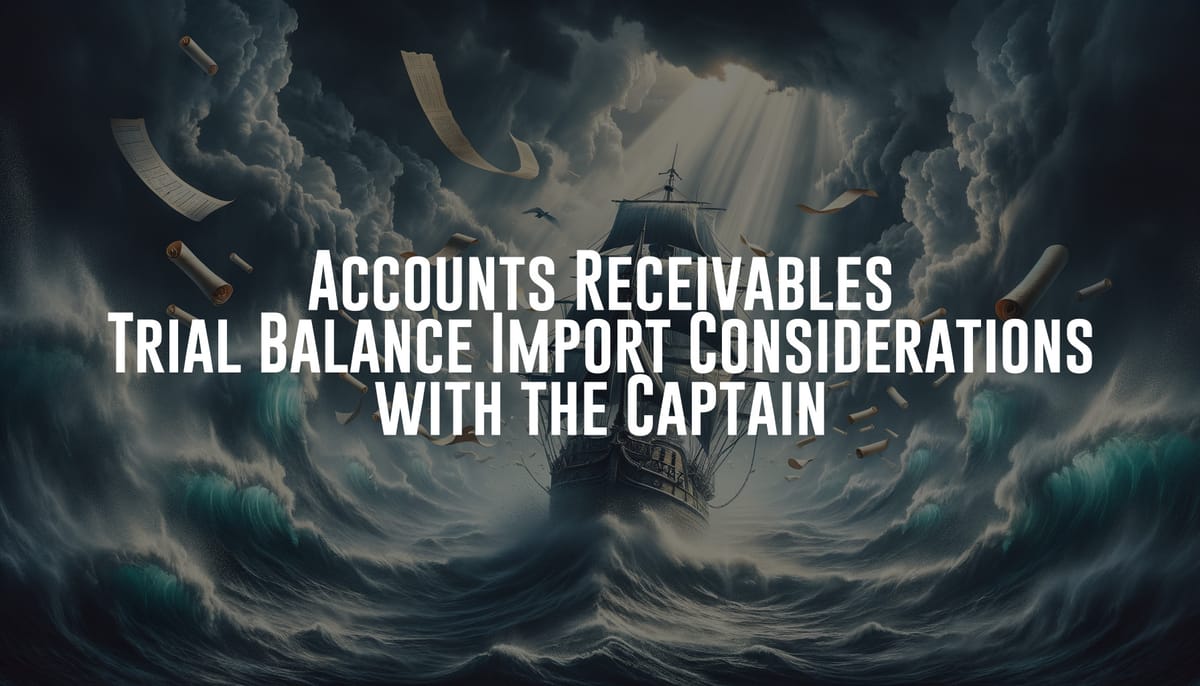Accounts Receivables Trial Balance Import Considerations with the Captain
Set sail on a voyage through the turbulent seas of Accounts Receivables Trial Balance imports. Learn how to tackle unassociated values and keep your AR Aging shipshape!

Ahoy, me hearties! Gather round the ol’ pirate’s fire as Captain Twilight spins a tale of maritime mysticism and financial mastery! Today’s adventure takes us into the tempestuous waters of Accounts Receivables (AR) Trial Balance imports. Aye, the life of an accountant can be as thrilling as any pirate's journey across the seven seas. So hoist the Jolly Roger and let’s set sail into the intricate world of AR!
The Lay of the Land: Understanding AR Trial Balance
Imagine yer ship’s hold, filled to the brim with treasures and booty hard-won from distant shores. Each gleamin' piece has a rightful owner, a record of its place in yer ledger. But what if some trinkets ain't properly accounted fer? They'd be like cargo adrift in the briny deep, causin' no end of trouble for yer navigation. Similarly, in the realm of Accounts Receivables, every transaction must be rightly attributed to the correct customer to ensure the smooth sailing of your financial ship.
The Trial Balance is akin to yer ship's log; it accounts for all debits and credits, lettin' you know how the ship of finance is balanced. But beware, me hearties, fer when values in your AR Trial Balance aren’t associated with the right customers, it’s like havin' mislaid cargo—lead to a cluttered AR Aging and a troubled voyage ahead.
The Enigma of Unassociated Values
Now, let’s talk booty that doesn’t belong in yer hold. The unassociated values in AR might come from various sources like misposts, incorrect data entry, or erroneous uploads. These stray treasures disrupt yer AR Aging reports, making it harder to see which customers owe what and how much.
Picture this: yer AR Aging report is like a treasure map. Each overdue invoice is an 'X' marking the spot. When unassociated values creep in, it’s like someone spillin' ink on yer map—a sure way to lose direction and confuse the crew.
The Captain’s Master Plan
When faced with the troubling issue of unassociated values, Captain Twilight has a map—a master plan. Here be the steps:
- Identify the Unassociated Values: First, chart the waters. Identify which values are adrift and where they come from. Scrutinize your trial balance for anomalies.
- Inspect the Source: Next, inspect from whence these values hail. Check your entries, imports, and integrations. Sometimes a rogue entry or an import gone awry is the culprit.
- Reconcile with the General Ledger: Align your AR Trial Balance with the general ledger. This step can shed light on discrepancies and highlight the unassociated treasures.
- Clean the AR Aging: Once identified, you'll want to remove these values from your AR Aging report. This might mean correcting the original entries, making adjustments, or allocating the values to the proper accounts.
- Implement a Control Mechanism: Set up controls to prevent future occurrences. These can be anything from stricter data entry protocols to automated checks and balances during imports.
Voyage to a Cleaner AR Aging Report
Upon tighten' yer ship’s operations and correcting misassociated values, you’ll steer toward clearer waters. Your AR Aging report will reflect accurate, actionable data that’ll show which customers owe what and when, thereby makin' collections a breeze.
But don’t lower the flag just yet, for there’s still more wisdom to share. Let’s delve deeper, shall we?
The Ledger's Secret: Automation and Consistency
Picture ye an enchanted compass, always pointing true despite the foulest of storms. Automation tools work much the same magic in the world of AR. Implement software solutions that automate data entry, flag discrepancies, and ensure consistency. It’s like having a crew that never tires, always vigilant and error-free.
A Tale of Vigilance: Regular Audits
Just as a ship requires regular care and keen eyes to avoid barnacles and water rot, so too does your accounting ledger. Perform regular audits to identify discrepancies early. It’s easier to deal with a single rogue entry than a flotilla of them. Keep your ledger clean as a polished deck.
The Ocean’s Wisdom: Training Your Crew
Even the best of vessels can flounder with an unskilled crew. Train yer mates well in the art of data entry, reconcile guidance, and regular AR Aging reviews. A well-drilled crew can prevent many a disaster and keep the ship running smooth.
Scrolls and Sails: Documentation
Never underestimate the power of proper documentation, mates. Record each procedure like a treasure map that’ll guide your future self or successors. Detailed documentation provides a reference that's invaluable in troubleshooting or training new crew members.
Conclusion
So there ye have it, brave navigator. Accounts Receivable management may seem as treacherous as the Devil’s Triangle, but equipped with the wisdom of Captain Twilight, ye are more than capable of steering through the clouded waters. Whether it's the aligning of trial balances or the banishment of unassociated values, these secrets will keep yer accounting books as balanced as a steady ship.
Now sail forth with confidence, and remember—the tides of finance may ebb and flow, but a well-managed AR is your sturdy vessel through the stormiest of seas. Until next time, fair winds and following seas to ye!





